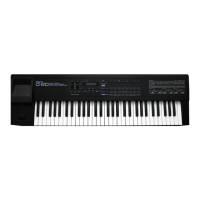
Do you have a question about the Roland D-20 and is the answer not in the manual?
| Timbrality | 8 parts |
|---|---|
| Keyboard | 61 keys |
| Year Released | 1988 |
| LFO | Yes |
| Velocity Sensitivity | Yes |
| Aftertouch | No |
| MIDI | In, Out, Thru |
| Weight | 9.5 kg |
| Synthesis Type | Linear Arithmetic Synthesis |
| Effects | Chorus, Reverb |
| ROM | 128 PCM waveforms |
| Outputs | Stereo, Headphones |
| Waveforms | PCM |
| Filter | Digital Filter |
| Memory | Internal RAM, optional RAM cards |
| Display | LCD (2 lines, 16 characters) |
| Type | Digital Synthesizer |
| Oscillators | 2 per voice |
Controls pitch and vibrato effects for sound manipulation.
Houses the internal floppy disk drive for data storage.
Shows current operational status, parameters, and data.
Primary control for turning the unit on and off.
Ports for connecting external MIDI devices for data exchange.
Overview of sound sources, operational modes, and core capabilities.
Explains Play, Rhythm, Edit, Recording, Data Transfer, and ROM Play modes.
Details sound structure, polyphony, and voice limits.
Steps for turning on and initializing the D-20.
How to choose and change sounds (patches) from memory.
Using Bender Lever, Velocity, and Hold for dynamic expression.
Playing and controlling built-in rhythm patterns and tracks.
Utilizes the built-in metronome for practice and timing.
Adjusts the overall pitch of the instrument for tuning.
Shifts the keyboard's pitch to play in different musical keys.